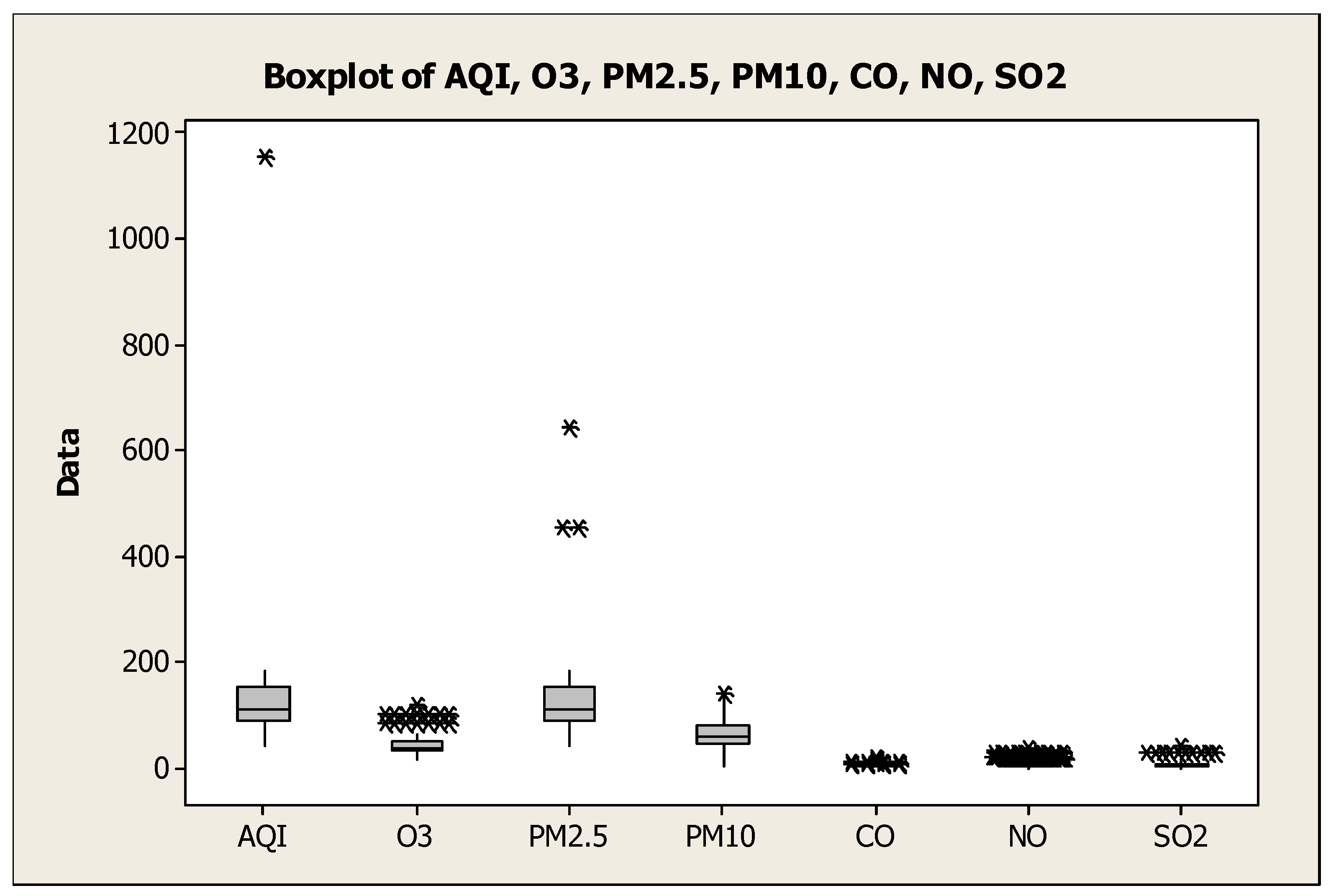Air Quality Index: Case of One-Day Monitoring of 253 Urban and Suburban Towns in Nigeria †
Abstract
:1. Introduction
2. Materials and Methods
3. Results and Discussion
4. Conclusions
Funding
Institutional Review Board Statement
Informed Consent Statement
Data Availability Statement
Acknowledgments
Conflicts of Interest
Abbreviations
| AQI | Air Quality Index |
| IoT | Internet of Things |
| WHO | World Health Organization |
| NGO | Nongovernmental organization |
References
- Manisalidis, I.; Stavropoulou, E.; Stavropoulos, A.; Bezirtzoglou, E. Environmental and Health Impacts of Air Pollution: A Review. Front. Public Health 2020, 8, 14. [Google Scholar] [CrossRef] [PubMed] [Green Version]
- Kemper, C.; Chaudhuri, S. Air pollution: A silent killer in Lagos. World Bank Blogs. Published on Africa Can End Poverty. 2020. Available online: https://blogs.worldbank.org/africacan/air-pollution-silent-killer-lagos (accessed on 23 March 2021).
- WHO. WHO Global Urban Ambient Air Pollution Database (Update 2016). Public Health, Environmental and Social Determinants of Health (PHE). 2016. Available online: https://www.who.int/phe/health_topics/outdoorair/databases/cities/en/ (accessed on 1 May 2021).
- USEPA. Air Quality Index A Guide to Air Quality and Your Health. EPA-454/R-00-005. 2000. Available online: http://www.epa.gov (accessed on 23 June 2021).
- Abulude, F.O.; Damodharan, U.; Acha, S.; Adamu, A.; Arifalo, K.M. Preliminary Assessment of Air Pollution Quality Levels of Lagos, Nigeria. Aerosol. Sci. Eng. Aerosol. Sci. Eng. 2021, 5. [Google Scholar] [CrossRef]
- Tutiempo Network, S.L. Available online: https://www.calidadaire.net/nigeria.html (accessed on 1 May 2021).
- Akinwumiju, A.S.; Ajisafe, T.; Adelodun, A.A. Airborne Particulate Matter Pollution in Akure Metro City, Southwestern Nigeria, West Africa: Attribution and Meteorological Influence. J. Geovis. Spat. Anal. 2021, 5, 11. [Google Scholar] [CrossRef]

| AQI | O3 | PM2.5 | PM10 | CO | NO | SO2 | |
|---|---|---|---|---|---|---|---|
| Mean | 117.31 | 44.87 | 117.4 | 66.87 | 5.48 | 6.84 | 6.58 |
| Std Dev | 73.33 | 16.32 | 55.95 | 27.4 | 2 | 6.94 | 6.25 |
| Coef. Var | 62.51 | 36.36 | 47.66 | 40.98 | 45.45 | 101.49 | 94.96 |
| Minimum | 41 | 15 | 41 | 3 | 2 | 0 | 0 |
| Maximum | 184 | 118 | 645 | 143 | 19 | 37 | 42 |
| Q1 | 88 | 35 | 88 | 45 | 4 | 2 | 3 |
| Q3 | 153 | 51 | 153 | 83 | 6 | 7 | 8 |
| Skewness | 11.21 | 1.8 | 5.02 | 0.69 | 2.22 | 1.89 | 2.33 |
| Kurtosis | 15.8 | 4.18 | 39.68 | −0.19 | 7.76 | 3.07 | 7.11 |
| Daily AQI Colour | Levels of Concern | Values of Index | Description of Air Quality |
| Green | Good | 0 to 50 | Air quality is satisfactory, and air pollution possess little or no risk |
| Yellow | Moderate | 51 to 100 | Air quality is acceptable. However, there may be a risk for some people, particularly those who are unusually sensitive to air pollution |
| Orange | Unhealthy for Sensitive Groups | 101 to 150 | Members of sensitive groups may experience health effects. The general public is less likely to be affected |
| Red | Unhealthy | 151 to 200 | Some members of the general public may experience health effects; members of sensitive group may experience more serious health effects |
| Purple | Very Unhealthy | 201 to 300 | Health alert: The risk of health effects is increased for everyone |
| Maroon | Hazardous | 301 and higher | Health warning of emergency conditions: everyone is more likely to be affected |
| AQI | O3 | PM2.5 | PM10 | CO | NO2 | SO2 | |
|---|---|---|---|---|---|---|---|
| AQI | 1 | ||||||
| O3 | 0.12 | 1 | |||||
| PM2.5 | 0.36 | 0.29 | 1 | ||||
| PM10 | 0.31 | 0.52 | 0.52 | 1 | |||
| CO | 0.25 | 0.46 | 0.49 | 0.55 | 1 | ||
| NO2 | 0.21 | 0.66 | 0.45 | 0.66 | 0.69 | 1 | |
| SO2 | 0.15 | 0.6 | 0.31 | 0.59 | 0.3 | 0.61 | 1 |
Publisher’s Note: MDPI stays neutral with regard to jurisdictional claims in published maps and institutional affiliations. |
© 2021 by the authors. Licensee MDPI, Basel, Switzerland. This article is an open access article distributed under the terms and conditions of the Creative Commons Attribution (CC BY) license (https://creativecommons.org/licenses/by/4.0/).
Share and Cite
Abulude, F.; Abulude, I.; Oluwagbayide, S.; Afolayan, S.; Ishaku, D. Air Quality Index: Case of One-Day Monitoring of 253 Urban and Suburban Towns in Nigeria. Environ. Sci. Proc. 2021, 8, 4. https://doi.org/10.3390/ecas2021-10342
Abulude F, Abulude I, Oluwagbayide S, Afolayan S, Ishaku D. Air Quality Index: Case of One-Day Monitoring of 253 Urban and Suburban Towns in Nigeria. Environmental Sciences Proceedings. 2021; 8(1):4. https://doi.org/10.3390/ecas2021-10342
Chicago/Turabian StyleAbulude, Francis, Ifeoluwa Abulude, Samuel Oluwagbayide, Segun Afolayan, and Deborah Ishaku. 2021. "Air Quality Index: Case of One-Day Monitoring of 253 Urban and Suburban Towns in Nigeria" Environmental Sciences Proceedings 8, no. 1: 4. https://doi.org/10.3390/ecas2021-10342
APA StyleAbulude, F., Abulude, I., Oluwagbayide, S., Afolayan, S., & Ishaku, D. (2021). Air Quality Index: Case of One-Day Monitoring of 253 Urban and Suburban Towns in Nigeria. Environmental Sciences Proceedings, 8(1), 4. https://doi.org/10.3390/ecas2021-10342






